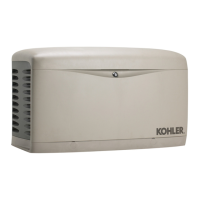TP-6805 8/15 107Section 6 Component Testing and Adjustment
6.9 Frequency Adjustment
The engine speed determines the generator output
frequency; 60 Hz units operate at 3600 RPM and 50 Hz
units run at 3000 RPM. When the system frequency
setting on the controller is changed, the engine run
speed will automatically update.
Set the system frequency to 50 or 60 Hz before adjusting
the engine speed. The system frequency can be
adjusted using the controller keypad on the RDC2
controller or using a personal computer running Kohlerr
SiteTecht software. The DC2 controller must be
adjusted using SiteTecht software.
Frequency Adjustment Procedure
1. Use the RDC2 controller’s Genset System menu or
use SiteTech to set the system frequency to 50 or
60 Hz.
Note: Although the RDC2 System Frequency
menu scrolls through numbers from 51-59,
the only available settings are 50 and 60 Hz.
2. Open the generator set line circuit breaker.
3. Attach a frequency meter to the AC output leads.
4. Start and run the generator set. Verify that the
output frequency matches the desired system
frequency.
5. Check stability with the generator set running and
with no load applied. If the generator set speed is
unstable, hunts, or surges, use SiteTech to verify
that the engine speed control parameters are set to
the default settings (Engine Speed Governor
settings in SiteTech).
Note: Hunting/surging problems thought to be
caused by the governor are more likely to be
caused by fuel supply, engine or carburetor
problems. If the generator set speed is
unstable, hunts, or surges, check for the
cause using the procedure in Section 5.10.3
before proceeding.
6. Apply rated load to the generator set and observe
the frequency reading. The no load and full load
frequency should not vary more than 0.4 Hz from
the rated generator frequency.
a. If the frequency varies significantly more than
0.4 Hz from the system frequency, check that
the carburetor throttle plate opens completely
without sticking and check the carburetor
adjustment.
b. If the frequency is steady but running below
rated frequency, verify that the throttle is
completely open. If so, reduce the load on the
engine until the frequency recovers.
7. Check for hunting and surging at full load. If the
generator speed is unstable, hunts, or surges, the
governor gain may require adjustment. See
Section 6.9.1, Engine Speed Gain adjustment, for
instructions to change the governor gain.
8. Remove the load and observe the frequency. The
frequency should return to the rated level within a
few seconds. If the speed does not recover or the
generator controller shuts down for over frequency
or overspeed, it may be necessary to adjust the
governor gain. See Section 6.9.1.
6.9.1 Engine Speed Gain Adjustment
for the Governor
Note: Adjusting the governor gain may cause the
generator to operate incorrectly.
Note: Typical governor gain settings are between 35
and 65. Settings outside this range are not
recommended for extended use (troubleshooting
only).
The governor gain controls how much throttle
movement is tied to a given change in the generator
speed. Higher gains make the throttle move more
aggressively on a speed change, lower gains make the
throttlemovemoreslowly.
Using Kohler SiteTech, adjust the Engine Speed Gain
Adjustment setting in the Engine Speed Governor
group. Change the governor gain setting in small steps
(5 or less).
D If the engine is hunting slowly (changes from
maximum to minimum speed in more than a second),
increase the governor gain.
D If the generator is hunting quickly (maximum to
minimum speed several times per second), decrease
the gain.
D If changing the gain makes the hunting worse, try
changing the gain in the other direction.

